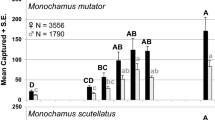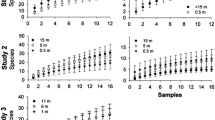Abstract
The use of flight interception traps (window traps) has been criticized for catching too many species without affinity to the immediate surroundings. We study aspen retention trees left for conservation reasons in a boreal forest in south-eastern Norway, and investigate how placement of window traps affects the beetle species assemblage, abundance of habitat specialists, saproxylic species and vagrant species. We also test the correlation between beetle trappings and beetle exit holes in wood. The window traps clearly responded to the immediate surroundings of the trap. Traps located on tree trunks had a different species assemblage than traps hanging freely. Traps mounted on trees caught more aspen associated beetles and less vagrant species than their free-hanging counterparts. The differences were larger when trees were dead than alive. There was a significant positive correlation between presence of individuals in the trunk-window traps and presence of exit holes for three aspen associated species. Thus, the trapping results indicated successful reproduction, showing that aspen associated beetles are not only attracted to but also utilise aspen retention trees/high stumps left in clear-cuts. This indicates that this conservation measure in forest management can have positive, alleviating effects concerning the dead wood deficit in managed boreal forest.




Similar content being viewed by others
References
Alinvi O, Ball JP, Danell K, Hjalten J, Pettersson RB (2007) Sampling saproxylic beetle assemblages in dead wood logs: comparing window and eclector traps to traditional bark sieving and a refinement. J Insect Conserv 11:99–112
Bílý S, Mehl O (1989) Longhorn beetles (Coleoptera, Cerambycidae) of Fennoscandia and Denmark. Fauna Ent Scand 22:1–204
Dahlberg A, Stokland J (2004) Vedlevande arters krav på substrat—sammanställning och analys av 3 600 arter. Rapport fra Skogsstyrelsen No. 7. 75 pp (In Swedish, English abstr.)
Ehnström B, Axelsson R (2002) Insektsgnag i bark och ved. Artdatabanken, SLU, Uppsala 512 pp. (In Swedish)
Hansen V, Henriksen K, Rye B, Jensen-Haarup A 1908–1965: Danmarks Fauna, Biller 1–21. Copenhagen: G.E.C. Gads Forlag
Hansson L (1997) Boreal ecosystems and landscapes: structures, processes and conservation of biodiversity. Ecol Bull 46:1–203
Hunter MLJ (1990) Wildlife, forest and forestry. Principles of managing forests for biological diversity. Prentice Hall, New Jersey, 370 pp
Hyvarinen E, Kouki J, Martikainen P (2006) A comparison of three trapping methods used to survey forest-dwelling Coleoptera. Eur J Entomol 103:397–407
Jonsell M, Weslien J (2003) Felled or standing retained wood—it makes a difference for saproxylic beetles. For Ecol Manage 175:425–435
Kaila L, Martikainen P, Punttila P (1997) Dead trees left in clear-cuts benefit saproxylic Coleoptera adapted to natural disturbances in boreal forest. Biodiv Conserv 6:1–18
Kålås JA, Viken Å, Bakken T (eds) (2006) Norsk Rødliste 2006-Norwegian red list. Artsdatabanken, Norway, 416 pp
Lindhe A, Lindelow A, Asenblad N (2005) Saproxylic beetles in standing dead wood density in relation to substrate sun-exposure and diameter. Biodiv Conserv 14:3033–3053
Martikainen P, Kouki J (2003) Sampling the rarest: threatened beetles in boreal forest biodiversity inventories. Biodiv Conserv 12:1815–1831
Moen A (1998) Vegetasjonsatlas for Norge. Statens kartverk, Norge
Økland B (1996) A comparison of three methods of trapping saproxylic beetles. Eur J Entomol 93:195–209
Palm T (1951) Die Holz- und Rinden-Käfer der nordschwedischen Laubbäume. Meddn St SkogsforskningsInst 40(2):1–242
Palm T (1959) Die Holz- und Rinden-Käfer der süd- und mittelschwedischen Laubbäume. Opusc Entomol Suppl 16:1–371
Ranius T, Jansson N (2002) A comparison of three methods to survey saproxylic beetles in hollow oaks. Biodiv Conserv 11:1759–1771
Saint-Germain M, Buddle CM, Drapeau P (2006) Sampling saproxylic Coleoptera: scale issues and the importance of behavior. Environ Entomol 35:478–487
Stokland JN, Meyke E (in press) The Nordic saproxylic database—an emerging overview of the biological diversity in dead wood. La Terre et la Vie—Revue d’Ecologie
Sverdrup-Thygeson A, Borg P, Bergsaker E (2005) Miljøhensyn på hogstflatene—før og etter Levende Skog. NORSKOG-rapport No.1-2005, 62 pp (In Norwegian, English abstr.)
Sverdrup-Thygeson A, Ims RA (2002) The effect of forest clearcutting in Norway on the community of saproxylic beetles on aspen. Biol Conserv 106:347–357
Wikars LO, Sahlin E, Ranius T (2005) A comparison of three methods to estimate species richness of saproxylic beetles (Coleoptera) in logs and high stumps of Norway spruce. Can Entomol 137:304–324
Acknowledgements
We are grateful to Espen Wandås for assistance in field, to Sindre Ligård for identification of beetles and to Steve Coulson, Erik Framstad and Frode Ødegaard for useful comments on an earlier version of the manuscript. The study was possible due to grants from the Norwegian Research Council (Part of NFR project no. 140161/110 and 163230).
Author information
Authors and Affiliations
Corresponding author
Rights and permissions
About this article
Cite this article
Sverdrup-Thygeson, A., Birkemoe, T. What window traps can tell us: effect of placement, forest openness and beetle reproduction in retention trees. J Insect Conserv 13, 183–191 (2009). https://doi.org/10.1007/s10841-008-9141-x
Received:
Accepted:
Published:
Issue Date:
DOI: https://doi.org/10.1007/s10841-008-9141-x




